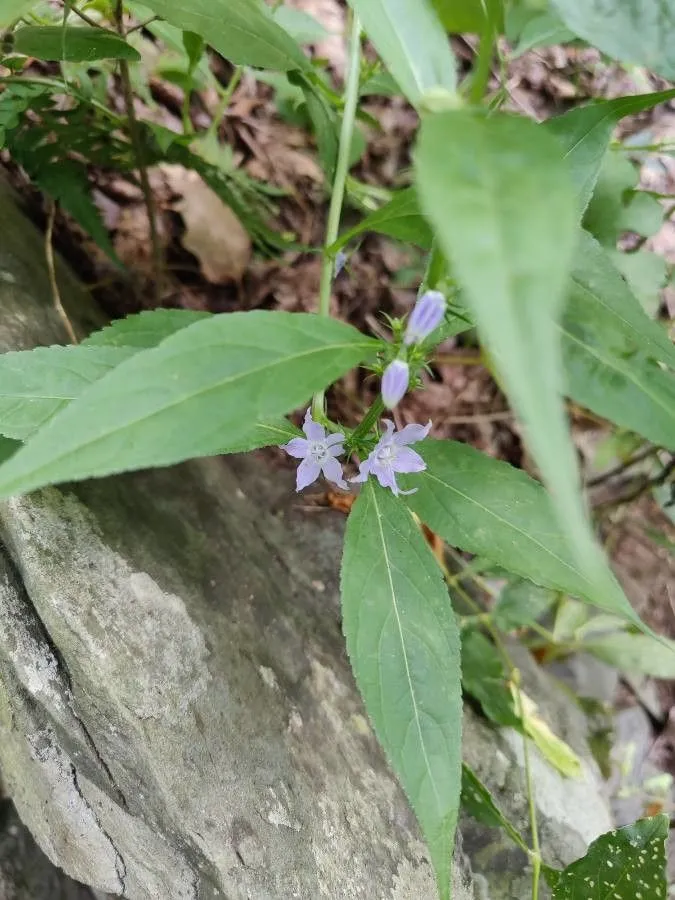
Author: L.
Bibliography: Sp. Pl.: 164 (1753)
Year: 1753
Status: accepted
Rank: species
Genus: Campanula
Vegetable: False
Observations: Unknown
The American bellflower, known scientifically as Campanula americana, is a captivating plant species that belongs to the Campanulaceae family. This enchanting plant was first described in the seminal work “Species Plantarum” in 1753 by the renowned botanist Carl Linnaeus, denoted by the abbreviation ‘L.’
American bellflower is celebrated for its striking blooms, which typically display vibrant shades of blue or violet, creating a beautiful contrast against the greenery of its natural habitat. These flowers often grow in clusters, forming a charming bell-like shape that gives the plant its common name. The broad, lance-shaped leaves add to the plant’s ornamental appeal.
This species primarily thrives in woodland areas, meadows, and along the edges of streams, where it can soak up dappled sunlight and benefit from moist, well-drained soil. While it is a perennial in some regions, it may also behave as a biennial, depending on the local climate and environmental conditions. During its flowering season, which usually spans from mid-summer to early fall, the American bellflower becomes a beacon for pollinators, attracting bees, butterflies, and other insects, thereby contributing to the ecosystem’s biodiversity.
Cultivating Campanula americana can be a delightful addition to gardens, especially those aiming for a naturalistic or woodland theme. It requires minimal care once established, making it an excellent choice for both novice and experienced gardeners. Despite its delicate appearance, the American bellflower is relatively hardy and can adapt to different soil types, provided there is adequate moisture and partial shade.
Though specific ethnobotanical uses or historical observations of Campanula americana remain undocumented, its aesthetic and ecological value are undeniable. Its presence in a garden not only enhances the visual appeal but also supports pollinator populations, facilitating a healthier and more vibrant environment.
In summary, the American bellflower (Campanula americana) is a charming and resilient member of the Campanulaceae family. Its remarkable blooms and ease of cultivation make it a favorite among garden enthusiasts and a vital component of natural habitats, showcasing nature’s splendor and diversity.
Eng: american bellflower, tall bellflower
Swe: amerikansk blåklocka
En: American bellflower, Tall bellflower, American-Bellflower
Zh: 美洲风铃草
Fi: Amerikankello
Sv: Amerikansk blåklocka
Zh-tw: 美洲風鈴草
Taken Jul 12, 2021 by Courtney Wiseman (cc-by-sa)
Taken Jul 18, 2020 by Monique Aris (cc-by-sa)
Taken Aug 26, 2022 by Emily Risinger (cc-by-sa)
Taken Jul 13, 2019 by Carolyn Herman (cc-by-sa)
Taken Jul 27, 2021 by Jordan Wallin-Swanson (cc-by-sa)
Taken Jul 29, 2022 by Diana Beardsley (cc-by-sa)
Taken Jul 30, 2019 by Teena Cauffman (cc-by-sa)
Taken Jul 18, 2020 by Kevin Klatt (cc-by-sa)
Taken Aug 26, 2021 by sherry gray (cc-by-sa)
Taken Aug 11, 2021 by Norman Vedder (cc-by-sa)
Taken Jul 5, 2020 by Serena boettcher (cc-by-sa)
Taken Jul 27, 2022 by yangsheng zhang (cc-by-sa)
Taken Jul 25, 2022 by Sonlight (cc-by-sa)
Taken Jul 30, 2022 by Theresa (cc-by-sa)
Taken Jul 11, 2002 by EOL − Steven J. Baskauf (cc-by-nc-sa)
Taken Jun 22, 2012 by EOL − Ron Thomas (cc-by-nc-sa)
Taken Jun 22, 2012 by EOL − Ron Thomas (cc-by-nc-sa)
Taken Jun 22, 2012 by EOL − Ron Thomas (cc-by-nc-sa)
Family: Myrtaceae Author: (F.Muell.) K.D.Hill & L.A.S.Johnson Bibliography: Telopea 6: 402 (1995) Year: 1995 Status:…
Family: Rubiaceae Author: Pierre ex A.Froehner Bibliography: Notizbl. Bot. Gart. Berlin-Dahlem 1: 237 (1897) Year:…
Family: Sapindaceae Author: Koidz. Bibliography: J. Coll. Sci. Imp. Univ. Tokyo 32(1): 38 (1911) Year:…
Family: Asteraceae Author: A.Gray Bibliography: Pacif. Railr. Rep.: 107 (1857) Year: 1857 Status: accepted Rank:…
Family: Fabaceae Author: Medik. Bibliography: Vorles. Churpfälz. Phys.-Ökon. Ges. 2: 398 (1787) Year: 1787 Status:…
Family: Aspleniaceae Author: (Cav.) Alston Bibliography: Bull. Misc. Inform. Kew 1932: 309 (1932) Year: 1932…